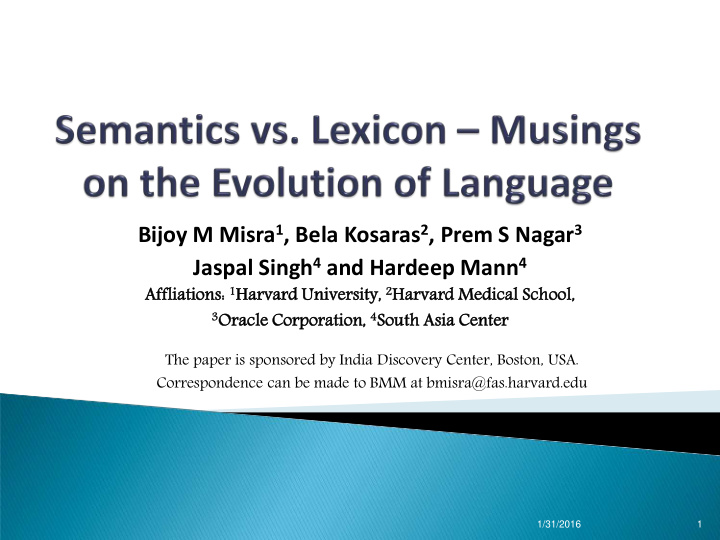



Bijoy M Misra 1 , Bela Kosaras 2 , Prem S Nagar 3 Jaspal Singh 4 and Hardeep Mann 4 Afflia liatio ions: s: 1 Harvard U Univer ersit sity, 2 Harvard M Medi dical School, 3 Orac Oracle C Corp rporat ration, , 4 South As Asia C Cen enter The paper is sponsored by India Discovery Center, Boston, USA. Correspondence can be made to BMM at bmisra@fas.harvard.edu 1/31/2016 1
1. The Problem 2. Steps and Time Delays in Creating Speech 3. Semantic Representation in the Brain 4. भतृरॎह�र B hartṛhari and वाकॎयपद�य V ākyapadīya 5. Nouns and Verbs 6. Sound and Word 7. Cognitive Grammar 8. Vocalization, Creation of Word 9. Prosody and Vowels 10. Sentence structure and Cultural imprint 11. Sound as Signature 12. Evolution of Language 1/31/2016 2
Semantics: the meaning of a word deciphered in hearing 1. and context Lexicon : the meaning of a word obtained through a 2. dictionary Problem : 3. a. How does the brain function? b. How do sounds convert to create an alphabetic rendering? c. What does thinking consist of? 1/31/2016 3
1/31/2016 4
1. Lexical selection from Concept Time duration: 100-225 milliseconds पशॎयनॎती “ paśyantī “ 2. Phonological Code Retrieval Time duration: 200-400 milliseconds मधॎयमा “ madhyamā ” 3. Self-Monitoring Time duration: 275-400 milliseconds No equivalent known term 4. Syllabification Time duration: 400-600 milliseconds No equivalent known term 5. Phonetic Encoding and Articulation Time duration: 600 milliseconds वैखर� “ vaikharī ” ( Indefrey and Levelt, 2004) 1/31/2016 5
1/31/2016 6
• fMRI reading experiments on bilingual speakers (Buchweiz, Prat; review paper, 2013) • Portuguese and English (Lexical) Words having same meanings pointed to the same memory location • Japanese (logographic) and Korean (syllabic) Recognition and processing of words Letter to sound mappings • Sentence-level and word-level processing 1/31/2016 7
• We hear sequential noise – धॎव�न dhvani • Between the pauses, we have शबॎद śabda • In śabda , we have one or more पद pada • A pada consists of one or more वणरॎ varṇa • A group of (one or more) śabda making a meaning make a वाकॎय vākya • A vākya when heard carries a meaning independent of the component parts • Each group of objects can create a meaning different from its component parts. 1/31/2016 8
• Lexical meaning – अथरॎ artha Obtained from local memory Cultural use Aid in communication • Semantic understanding achieved by सॎफोट Bursting forth Obtained from the deeper memory Time delay Superposition of the parsed concept to the concept in memory 1/31/2016 9
• Patricia Kuhl and associates (University of Washington, USA) Baby perception is as good as an adult Baby sound comprehension is superior to adult Baby has no nativity preference until 8 months. Lip-reading leads to nativity preference. • Baby speech is limited by motor control. “k”, “g”, “m”, “p” and “b” are discernible. All expressions are confined to these syllables. New syllables are learned by lip reading. • Baby expressive capacity as an adult Vowels and prosody rendition 1/31/2016 10
• Experiments (1993) on aphasia patients by Antonio and Tranel (University of Iowa, USA) Experiments used English language words. • Nouns and Verbs are retrieved differently. Nouns are stored as classes (clusters). Each known object was identified with precision. • Verbs were retrieved easier. Verbs had a better semantic mapping. • Inference drawn confirms सॎफोट theory. • Noun comprehension is through recall. • Verb comprehension is through analysis. 1/31/2016 11
• Effort was to teach English language to the Pirahã tribespeople by Jesuit priests. • The experiment failed denoting that the communicated language is cultural. • Confirms that the acquisition of new phonemes is through training and is not natural. • Pirahã has no separate words for colors, numbers and non-parental relationship. • The communication is through vowel rendering and prosodic delivery. • Nativity can die with lexical drills. 1/31/2016 12
• Cosmological significance of sound • Sound perception and recognition • Sound reproduction in imitation, training, repetition, identification • Sound as a conveyer of environment • Human voice, vocal chord, individual signature • Sound as expression of feelings and emotion • Rendering of words: Consonants and Vowels • Economy in expression • Expression vs. Communication • Sound Comprehension • Grammar 1/31/2016 13
1/31/2016 14
• “Cognitive Memory” • Deep, individual preference • Achieved through conceptual understanding • Accessed through recall, concentration and and meditation • Layered as background to “Lexical Memory” • Individual filter to help develop “Cognitive Memory” • It reciprocates �बनॎदु “bindu ” concept in Indian literature. • The filter can be termed “Cognitive Grammar,” innate to each individual. 1/31/2016 15
• Examples from sāntāḻi language • “o” – burning stick • “ot ” – earth • “ otā” – (verb) press down • “ote ” – (verb) listen • “ oṅ” – breath • “ok” – burn • “oj ” – work • “oh” -- pain • “or” – drag • “on” – grain • “og ” – mother. 1/31/2016 16
• Examples from oḍiā language • “ प ” “ pa” - “ �प ” “ pi” verb “to drink” • “ �पए ” “ pie” meaning “drinks normally” • “ �पउ�छ ” “ piuchi ” meaning “is drinking” • “ �पइ�छ ” “ piichi”meaning “has drunk” • “ �पउथाए ” “ piuthāe” meaning “habitually drinks” • “ �पइथाए ” “ piithāe” meaning “habitually drunk” • “ �पआहुए ” “ piāhue” meaning “drinking happens” • “ �पइहुए ” “ piihue ” meaning “facilitates in drinking”. • Note “ आ ” “ā” , “ इ ” “i”, “ उ ” “u” and “ ए ” “e” • More : “ क ” “ ka” “who”, “ का ” “ kā” “where”, “ �क ” “ ki” “what”, “ क े ” “ ke” “who (plural)”. • No “ क ु ” “ ku” in the set! 1/31/2016 17
1/31/2016 18
Thank You! 1/31/2016 19
Recommend
More recommend